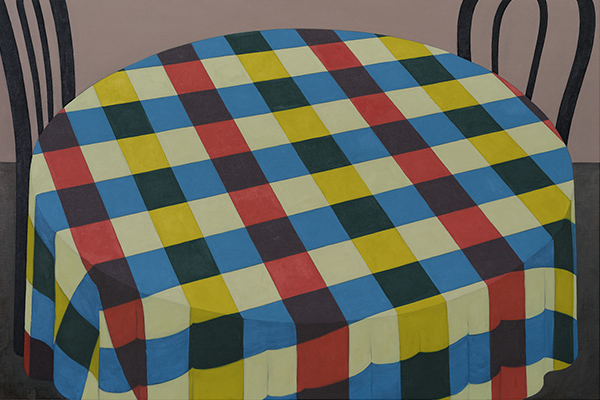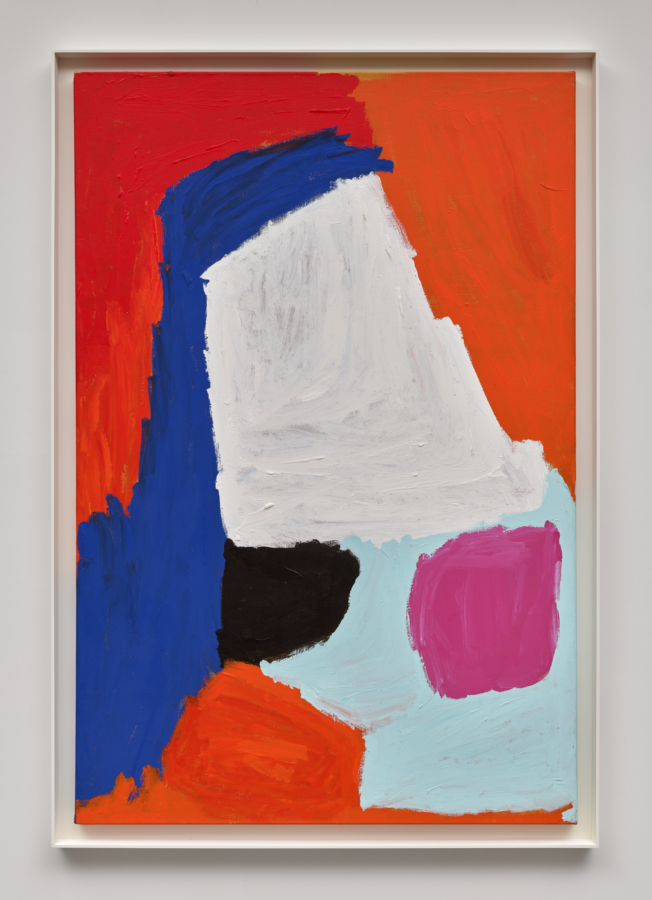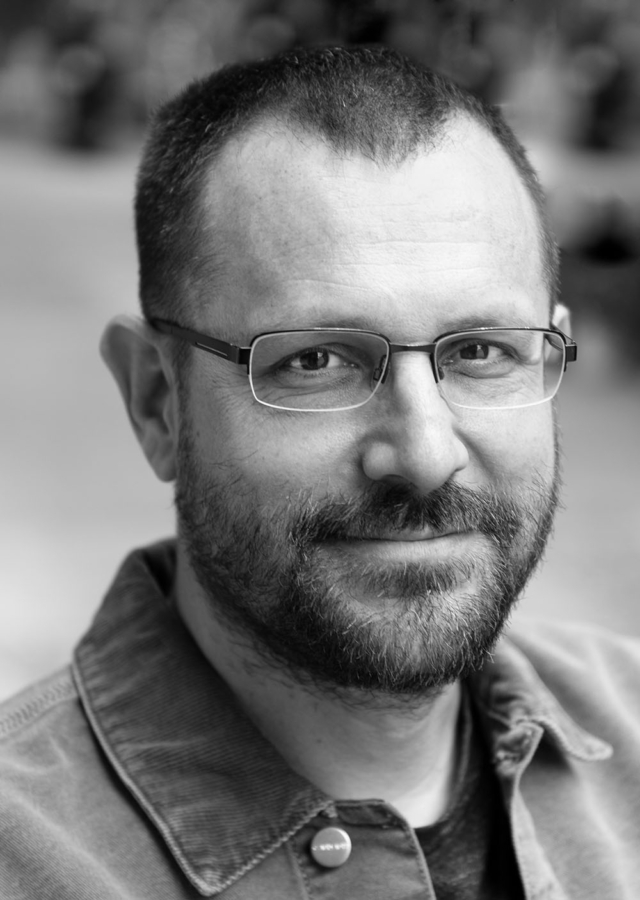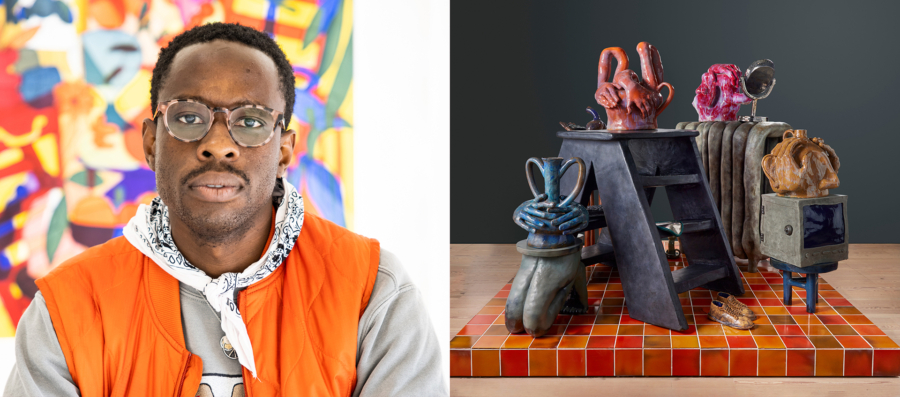April 23, 2019
Jonas Wood, Dallas Museum of Art, Dallas, April 23, 2019
Hans Ulrich Obrist I’m curious how you came to art, or how art came to you. How did your art begin, was it an epiphany?
Jonas Wood The true epiphany of thinking that I was an artist came when I arrived at grad school, because it was the first time that I was spending all of my time making art. Before that I was pursuing both science and art. But my grandfather was an art collector and I grew up with a lot of art, and my parents went to art school. My dad was an architect and my mom was a drama teacher, and they met at Yale. So I think that’s more the epiphany, my parents meeting.
HUO So that’s why your parents keep popping up in the work. I read this very revealing interview in which you talk about growing up with Matisse and Calder and Picasso.
JW My grandfather was a second-generation Jewish-American in upstate New York, and he became a doctor in Syracuse. He was successful, and he decided to get into fine art, and then later got into painting. From the age of sixty to ninety-five he painted. He’s the person who brought those artists into my life.
HUO You’ve mentioned the freshness of Calder’s colors. Can you tell us what inspired you about his work? Was it also the flatness of the colors?
JW The flatness, I think, and the shape and the color, and how his work is defined by his hand drawing a line. He’s obviously cutting out a piece of metal. And the lightness in his work—even though it’s sometimes made out of heavy materials, it’s floating. And the fact of an artist finding his own language in modern painting or modern sculpture. I gravitated to all of that. And also, I like the way he worked, the way that he kept his studio. Calder’s studios were fantastic, they were full of his ideas. He seemed to like to be in this giant space with all of his work, and he’d be working on one thing, and then he’d make something, put it to the side, make something else, put it to the side, and that’s how I always imagined working.
HUO And what about Matisse?
JW It’s something similar, but I gravitated to his cut outs, which is definitely a connection to Calder as well. A very similar thing, but a different person speaking the language. But it isn’t so much the lightness of Matisse’s painting that I respond to––it’s the patterns and the colors, the heavy patterning. I grew up with a very specific Matisse print that belonged to my grandfather.
HUO You have a BA in psychology, and you initially wanted to become a doctor. How did that enter your art?
JW I realized when I was choosing subject matter that certain things were more charged than others, and that I had trouble finishing and starting paintings because I wasn’t picking appropriate things to paint—appropriate for me. That’s part of what I’ve learned from studying psychology—thinking about what I connect to. Making a lot of paintings of my family or things that I was interested in made it more fun and interesting for me to paint.
HUO I always wonder: where does the student work end and the catalogue raisonne of the artist begin? What’s the number one work in your catalogue raisonne, the first work you no longer consider student work?
JW I would say a painting that I made right before I left grad school. But it was less the actual painting than the idea that was good. So then the catalogue raisonne probably starts right after I finished grad school, in 2002.
HUO And what would be the first work?
JW Probably a self-portrait.
HUO And that leads us to the exhibition we’re doing this interview for. Is it a survey?
JW Yes, it’s a painting survey show, but I’m able to bring together a number of portrait paintings that have never been shown. There’s a room of family members painted at different times, a room of artist friends, and a room of interiors/exteriors. There’s a still life with a skull in it that I made in my first painting show at Anton Kern in 2007, when I first started showing. The exhibition starts with that still life, along with a painting of me getting hypnotized. I went to this man’s garage to get hypnotized to quit smoking cigarettes, and I was super turned on by his room, and decided to make a painting from that. I think the show extrapolates from those two paintings.
HUO Plants are very present in the work. But the catalogue raisonne begins with portraits. When did the plants enter the work?
JW It was all connected. There really was a plant epiphany. When I left grad school, I was trying to pinpoint what I wanted to paint. I wanted to make still lifes because I thought that would help me become a better painter, and that coincided with moving to Los Angeles. Then, when I saw all the plants in Southern California, compared to the ones I was used to from growing up on the East Coast, it was a mind-blowing experience. It was like plants on acid from the Flintstones. Being able to start drawing and painting these things was really about the environment of Southern California. Even isolating parts of plants, the idea of something being clipped, I was riffing on the way that plants are shown in a horticulture book.
HUO You have a certain methodology that has a lot to do with collecting. You source images, then sometimes you collage in an analog way, and then you blow it up. Can you tell me a little bit about this methodology, how you work, and how photography is used?
JW My work is photography-heavy. More specifically, the origin of my work is in photography, but it isn’t about photography. I don’t think that photography is the first thing people think of when they see my work, even though I’m constantly photographing things, collecting things, finding things from my personal archive, or people are sending me things, or I’m just seeing things in the world. And then I’m making drawings of what I see.
HUO These are studies?
JW Yes, for bigger works. I might have a source image, and then I take things from it that I want. Sometimes I just take all the shapes of the pots and some of the shelves. Other times, I take the shapes of the room and then add things to it from my database of images.
HUO So the process begins with looking through the pictures, and then you add the collage with scissors and glue.
JW Exactly. There are things glued onto that one drawing. The methodology is the idea of something and then knowing that I can always add to or subtract from the image I’ve found. I’m using the images by tracing them and taking pieces of them out and then projecting them together and creating my own world, but using all of these source images. What often happens is that I source images from my own work and reconstitute them. So the process is not a scientific, one-through-fifty-step formula that gets me to the final work. There are many steps taken in between what I’ve just described, between finding a photo and making a painting. I never paint on the fly. I draw in a doodle kind of way, but I never paint that way. Painting’s a bit more mechanical, it involves building and figuring out how to make a piece and work from the back to the front of the canvas.
HUO When is a painting finished?
JW That’s the age-old question. How many paintings do you make a year? When is a painting finished? How many paintings do you keep? Those are three very common questions, but the hardest one to answer is definitely the second one. I know the elements of a work that need to be added up to a certain point, and then I get there. And then, usually, I have a lot of self-doubt about it right away.
HUO So doubt is always there?
JW Yeah. I think the doubt is always there. Sometimes I know a work is going to be awesome, and I’m going to pull it off, but there’s always an element of doubt. To be critical of one’s work, there has to be some doubt.
HUO You grew up with Warhol cow wallpaper, and you yourself make wallpaper works that also become rooms. How do these works enter the larger picture?
JW I like the idea of wallpaper, but so far all the wallpaper that I’ve made has been about pattern. It inhabits a space and other things interact with it. But I do think that aesthetically my work is reproducible, if that’s what you mean by the question—it could all be like wallpaper.
HUO Yes, that’s what I mean. Murals, which you also do.
JW I start with this little picture in my phone, or a little picture that I cut out, and then it can become as large or small as I choose. I look at the image and size it out. But if I wanted to make it huge, I would use a scale model to figure out if it’s working.
HUO I spoke to Alex Israel and asked him to give me a question for you, because I like the idea of an interview within an interview, like a Russian matryoshka.
JW I like that too.
HUO And so here is Alex’s question for you: “What is the importance of the hand in your work? Does the hand matter to you? I think the obvious answer to the question in your case is yes, of course, because your work seems to deviate from contemporary ideas about reproduction as pertaining to painting in exchange for an upholding of traditions of craft and the handmade. But actually, many of your paintings are translated in the studio by assistant painters from your drawings and studies,” which we see here. “So can the aura of the artist’s hand be transferred by a studio assistant? What are your thoughts?”
JW Hmmm. This is an astute question, because it gets at a major fear of mine when I decided to have assistants help me make my paintings. The question I would ask myself is, would this now not be authentic? Would this now not be handmade by me? If anyone had asked me when I was younger whether I would let another person touch my work, I would have said, “Hell no. Not over my dead body.” Because that’s what I was taught in grad school. This relates to what we were discussing earlier, about where my catalogue raisonne begins. Another way of stating that question could be: Where do you start to make your mature work, or how are you maturing as an artist? Those sort of issues collided when I began to expand my practice. My studio was growing and I was figuring out my process: I draw things out, I mix all the colors, and I have people paint by numbers. At the beginning, to test the process, I made one work myself and I had an assistant make one, and then I asked my wife what she thought. Initially, I was really nervous that this way of working would detract from the idea of things being handmade. I want my hand and my line and my color to always be relevant. And now I think that the way I approach my work, having other people involved in the creation of it, doesn’t sacrifice any of those things. So getting back to Alex’s question—the hand is the most important thing in my work, because the line, the line and the shape of what I make with my hand, is what I’m interested in as a painter. It’s crucial to my lineage as a painter, or the lineage I’ve sought to be a part of, those other artists I’ve looked up to, who are able to make a statement with two little squiggles on a piece of paper. You recognize that artist in the work because he or she has a particular touch. You have asked me about Calder or Matisse or Picasso or Van Gogh. They’re all defined by their line. So, yes. The answer is yes. The hand is the ultimate, because it could never be anybody else’s hand.
HUO And of course, the line is also in the portraits. Your catalogue raisonne begins with the portraits, and there are going to be portraits in Dallas. The people you’ve painted the most are basketball players, your mother, your father, I think. So can you talk a bit about the role of the portrait in your work?
JW When I decided I wanted to make an oil painting, my first thought was to paint the people in my family. I’ve just continued the tradition as a very intense wealth of emotional energy that I can tap. For me, it’s very important to confront the mirror of this person. Sometimes the process can be fun and exciting, for instance if the subject is a basketball player that I really like. And sometimes it’s difficult, if the subject is my mom or somebody that I’m emotionally connected to. I try to pick subjects who elicit strong responses in me, and obviously making a portrait of my parents a couple of years after they met in New Haven is really important to me. But I’m also simply responding to the way the picture is put together. A lot of these are conglomerations of images. They’re not straight appropriations— I’ve added or manipulated elements. The Sears Family Portrait, for example, is just a portrait that we had shot in the commercial studio at Sears. I’ve dug into this giant archive of family photos and found things I can paint.
HUO And what about the animals in your paintings? Do they represent a kind of bestiary?
JW I think they’re a reflection of growing up with a lot of animals. A lot of our family portraits include an animal or group of animals. My mom was kind of a hobbyist farmer, and we had goats and chickens and ducks and a parrot and different cats and dogs and rabbits and rats and cockatiels and geese and sheep. Not like a real farm—she was like the cat lady who, instead of having twenty-seven cats, had five goats and six chickens and a dog and some birds. These animals made their way into our family pictures, and that’s the link to my paintings.
HUO You’ve mentioned that you always start small, and it’s interesting that besides the photos you collect, you have things like basketball cards that are obviously readymades. But then you blow them up, and it’s often the same player. What’s the story with basketball, because already, in your early, pre–catalogue raisonne phase, in your psychedelic prints, there are some Red Sox t-shirts from the ’90s. What’s the obsession with—
JW Sports? I think it’s an East Coast thing, and my dad was into sports. I grew up with a lot of kids who loved sports, and there’s just a fervent sports thing. I loved all the Boston teams. I am just a diehard sports fan. And a sports portrait was a convenient readymade, as you say, when I needed a break from a difficult painting of my mother.
HUO Because the memories the work evoked were actually traumatic.
JW Yes, yes, horrible. Even painting friends can be an intense experience. So the readymade of the sports card was like, well, I don’t know these people, but I can still practice portraiture. I think that was an important aspect of it. They’re readymade portraits, so I don’t need to confront the memories of actual interactions. It doesn’t involve the same kind of psychic energy, but I can still work.
HUO Is the painting process fast or slow?
JW Slow, because I do a lot of things simultaneously, but I think if I were just working on one thing, it would probably be pretty fast.
HUO There are many parallel realities in a single work.
JW Yes. I just don’t want to be the guy who comes into the studio and has to work on that one thing every day and then be sad about it.
HUO Let’s talk about your interiors, and the connection to architecture. I was in the Calder archive in New York looking at his collaborations with architects. He worked with Oscar Niemeyer, he worked with Gordon Bunshaft, he worked with all the great architects of his time. Schindler’s architecture is featured in your works, and its influence is felt in your modernist interiors. The Dallas show will feature some of these interiors, so how do they fit into your overall oeuvre?
JW I’ve created levels of subject matter in my paintings. The interiors have a lot of stuff in them, there’s a lot of visual interaction, multiple vanishing points, and shifting perspectives. I look for those types of things. I’m interested in observing how somebody else put objects together in a space. I put these objects together in my interiors, but the configuration is based on what someone else has assembled. The space of the painting Children’s Garden is where I went to preschool, and my dad actually helped to build it. I think I’m just interested in how these spaces are put together. I like the challenges that architecture presents. I like the challenges of making a portrait. I like the challenges of making a still-life painting. I like painting. It’s fun.
HUO And what’s your definition of painting? Gerhard Richter says it’s the highest form of hope. What do you say?
JW The highest form of hope . . . I like that. It implies a new experience for somebody. Not like an acid trip, not that kind of experience, but the idea that you can take yourself somewhere else. My world is not real. My world is painted, but it’s based on the world that we live in.
HUO That’s a great definition. To come back to the interiors, they’ve been described as being uninhabited, which is not altogether true. Some of them are empty, others have people. What would you say about that? Are they inhabited? Uninhabited?
JW I’m definitely inhabiting all of them. When there’s not a person there, for instance if I’m creating a group of plants, the painting is not about the absence of people. It’s part of the tradition of making a painting that is a still life, defined as an interior. But it’s still a still life. It doesn’t move. There’s nobody in the painting. It’s set up. I’m painting from images that I assemble and move around, eliminating things I don’t like and adding others that appeal to me. I would describe the painting as a stage, an empty stage. Sometimes there are players on the stage. And sometimes the painting’s just the stage, and the stage looks cool.



